Harmonic oscillator - Study guides, Class notes & Summaries
Looking for the best study guides, study notes and summaries about Harmonic oscillator? On this page you'll find 79 study documents about Harmonic oscillator.
Page 2 out of 79 results
Sort by
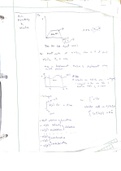
-
Comprehensive AP Physics C: Mechanics Notes
- Interview • 116 pages • 2022
-
- $6.19
- 1x sold
- + learn more
I took these notes in my senior year of high school for AP Physics C: Mechanics in 2021-2022. It is a comprehensive record of the following topics: Antiderivates & Calculus, Graphs, Constant Acceleration, Free Fall, Vectors in Two Dimensions, Projectile Motion, Rotation With Analogy to Translation, Rotational Kinematics, Mass, Weight, Force, Newton's Third Law, Normal Forces, The Atwood Machine, Free Body Diagrams With Contact Forces and Friction and Angles, Inclined Planes, Springs and Rubbe...
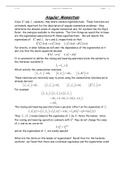
-
Physical Chemistry - Angular Momentum_lecture18-19
- Class notes • 12 pages • 2023
-
- $2.64
- + learn more
This course presents an introduction to quantum mechanics. It begins with an examination of the historical development of quantum theory, properties of particles and waves, wave mechanics and applications to simple systems — the particle in a box, the harmonic oscillator, the rigid rotor and the hydrogen atom. The lectures continue with a discussion of atomic structure and the Periodic Table. The final lectures cover applications to chemical bonding including valence bond and molecular orbital...

-
Physical Chemistry - Vibrational Spectroscopy_lecture35
- Class notes • 11 pages • 2023
-
- $2.64
- + learn more
This course presents an introduction to quantum mechanics. It begins with an examination of the historical development of quantum theory, properties of particles and waves, wave mechanics and applications to simple systems — the particle in a box, the harmonic oscillator, the rigid rotor and the hydrogen atom. The lectures continue with a discussion of atomic structure and the Periodic Table. The final lectures cover applications to chemical bonding including valence bond and molecular orbital...
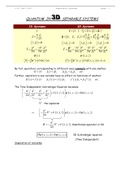
-
Physical Chemistry - Quantum in 3D Separable Systems_lecture16
- Class notes • 10 pages • 2023
-
- $2.64
- + learn more
This course presents an introduction to quantum mechanics. It begins with an examination of the historical development of quantum theory, properties of particles and waves, wave mechanics and applications to simple systems — the particle in a box, the harmonic oscillator, the rigid rotor and the hydrogen atom. The lectures continue with a discussion of atomic structure and the Periodic Table. The final lectures cover applications to chemical bonding including valence bond and molecular orbital...

-
Physical Chemistry - Huckel Molecular Orbital Theory_lecture31
- Class notes • 8 pages • 2023
-
- $2.64
- + learn more
This course presents an introduction to quantum mechanics. It begins with an examination of the historical development of quantum theory, properties of particles and waves, wave mechanics and applications to simple systems — the particle in a box, the harmonic oscillator, the rigid rotor and the hydrogen atom. The lectures continue with a discussion of atomic structure and the Periodic Table. The final lectures cover applications to chemical bonding including valence bond and molecular orbital...
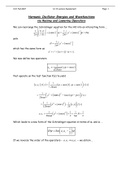
-
Physical Chemistry -The Harmonic Oscilator Energies and Wavefunctions via Raising and Lowering Operators_lecture12_sup1
- Class notes • 7 pages • 2023
-
- $2.64
- + learn more
This course presents an introduction to quantum mechanics. It begins with an examination of the historical development of quantum theory, properties of particles and waves, wave mechanics and applications to simple systems — the particle in a box, the harmonic oscillator, the rigid rotor and the hydrogen atom. The lectures continue with a discussion of atomic structure and the Periodic Table. The final lectures cover applications to chemical bonding including valence bond and molecular orbital...
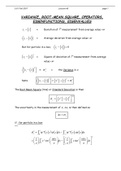
-
Physical Chemistry - Variance, Root-Mean Square, Operators, Eigen Functions, Eigen Values_lecture9
- Class notes • 6 pages • 2023
-
- $2.64
- + learn more
This course presents an introduction to quantum mechanics. It begins with an examination of the historical development of quantum theory, properties of particles and waves, wave mechanics and applications to simple systems — the particle in a box, the harmonic oscillator, the rigid rotor and the hydrogen atom. The lectures continue with a discussion of atomic structure and the Periodic Table. The final lectures cover applications to chemical bonding including valence bond and molecular orbital...

-
Principles of Electronic Communication Systems 4th Edition by Frenzel - Test Bank
- Exam (elaborations) • 235 pages • 2023
-
- $24.60
- + learn more
1. Gain means attenuation. FALSE 2. TRUE 3. FALSE 4. TRUE Blooms: 3. Apply Chapter: 02 Electronic Fundamentals for Communications Difficulty: Easy Section: 02.01 Gain, Attenuation, and Decibels Subtopic: Gain, Attenuation, and Decibels Topic: Electronic Fundamentals for Communications Blooms: 2. Understand Chapter: 02 Electronic Fundamentals for Communications Difficulty: Medium Section: 02.01 Gain, Attenuation, and Decibels Subtopic: Gain, Attenuation, and Decibels Topic: Electronic F...
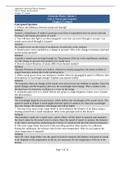
-
Conceptual Questions 1. What is the difference between sound and hearing? Solution Sound is a disturbance of matter (a pressure wave) that is transmitted from its source outward. Hearing is the human perception of sound. 2. You will learn that light is an
- Other • 32 pages • 2022
-
- $7.99
- + learn more
Conceptual Questions 1. What is the difference between sound and hearing? Solution Sound is a disturbance of matter (a pressure wave) that is transmitted from its source outward. Hearing is the human perception of sound. 2. You will learn that light is an electromagnetic wave that can travel through a vacuum. Can sound waves travel through a vacuum? Solution No, sound waves are the result of oscillations of molecules of the medium. 3. Sound waves can be modeled as a change in pressure. ...
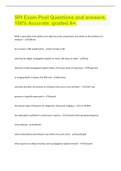
-
SPI Exam Pool Questions and answers. 100% Accurate, graded A+.
- Exam (elaborations) • 41 pages • 2023
-
Available in package deal
-
- $10.49
- + learn more
SPI Exam Pool Questions and answers. 100% Accurate, graded A+. What is described as the ability of an object to resist compression and relates to the hardness of a medium? - stiffness An increase in PRF would lead to - an increase in DF what has the higher propagation speed? air, bone, soft tissue or water - bone what has a lower propagation speed? water, soft tissue, bone or lung tissue - lung tissue as imaging depth increases, the PRF must - decrease what law describes the...

Study stress? For sellers on Stuvia, these are actually golden times. KA-CHING! Earn from your study resources too and start uploading now. Discover all about earning on Stuvia


